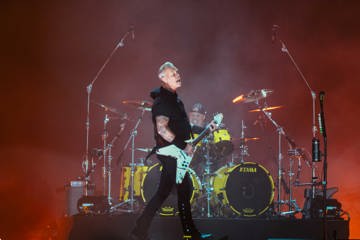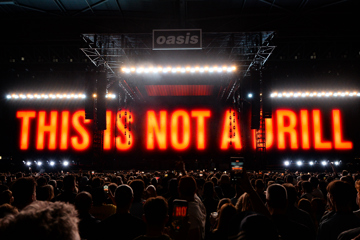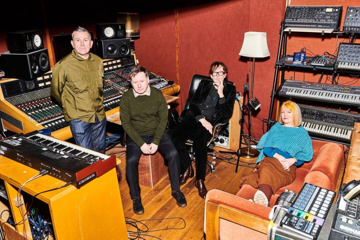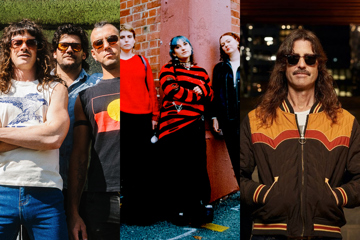Reflections Of Success
"I can tell quite clearly in the audiences at gigs that some only know the single, are only interested in hearing the single and then will leave the gig. At the start of the tour there was the odd moment where a few of us in the band got a little demoralised when we noticed 100, 200 people leaving the venue after we played the hit single."

Wouter “Wally” De Backer, under his Gotye moniker, has gone from creating music in his bedroom to playing it in huge arenas all over the world. Those who have got to know him within the last year or so as a result of his Making Mirrors album, and a certain song in particular, probably assume that it has all happened very suddenly. In reality though things built up for him over the course of more than over a decade. “It all felt very gradual I guess,” he recalls. “And to be able to say that I think I'm very lucky because something a lot of musicians struggle to obtain with their career, whether it's the business side of it or finding an audience or just being able to sustain working on music for a period of even a few years, is getting a momentum that continues. I'm fortunate with my Gotye project that through a combination of things over the last ten years it has been a constantly upward momentum. In retrospect I feel like I'm quite aware of different reasons why that's been and I certainly can still step back and realise that it's quite incredible. I guess I could kind of rationalise it a bit as well and see that it's not all just because I've made a certain type of music but it's also because there's a whole lot of persistence and one thing falling in place in front of another, and that kept happening over a period of time.”
There is no doubt that the massive success enjoyed by 2011's Making Mirrors album added considerable thrust to that momentum. Prior to the album's release though, De Backer was really unsure how it would be received. “I actually had a lot of doubts because it was quite a struggle to get it to sound the way I wanted it to,” he admits. “It took a lot longer to write the material and finish mixing it than I hoped – probably a year longer than I planned to spend on it – so there were times where I felt a bit like I'd missed my own subconscious deadlines and somehow as a result that made me a bit on edge about it. I was just feeling a bit like people wouldn't respond to the material positively and like this could really fall flat on its arse.”
Ubiquitous single Somebody That I Used To Know alone took care of any concerns he may have had. The song and its video (which has a staggering 335 million-plus hits on YouTube) seemed to immediately entrance everyone who heard and saw it. It does make you wonder if Gotye would be in the same place he is now had that song remained an album track, rather than being selected as a single. “Well, that's true,” he agrees. “It was the last song that was finished for the album and it did take five to six months almost of holding the whole record up to finish the song, so I guess that was partly because I had an inkling that it would be one of the strongest songs on the record. Up to then I'd sort of pencilled other songs in as singles but I also felt a bit like some of the strongest songs that I had finished on the record were actually some of the least single-worthy songs. But from the second I played Somebody to my managers and to a friend and my folks, when I'd just demoed the female part myself and even before I'd finished the arrangement of the second chorus, almost everybody seemed to think there was something quite engaging about that track so I had a pretty strong feeling already that it was worth waiting to finish. I don't know, I just had a belief that it was a good single choice, that it was just idiosyncratic enough to be not an obvious single but that it did work as a pop song.”
Don't miss a beat with our FREE daily newsletter
It has now become one of those singles that in its time has received airplay overload (up there with the likes of James Blunt's You're Beautiful and anything by Adele). De Backer believes that the song has now been overplayed in Australia but reveals that has also been the case in the US, where it also found him success, but that often it's not even his own version that gets played. “I don't know how much you know about American radio formatting, but there are so many different subcategories,” he explains. “Some of them played the original which has been great but what they call the rhythmic or R&B stations, the real super-pop dancey kind of stations, I think felt that because it has been such a commercial success and got so much attention they couldn't not play the song but they didn't really want to play the original. Then instead of actually even playing an official remix that I've at least approved they've just chosen to either commission or randomly search for someone to edit it that adds some really bad bottom end drums and some cheesy hi-hats on the top end, just kind of layered over the top of the master recording. They then put that on their playlist and they announce it as if it was the original song. I just don't think it's cool for radio stations to play something that's not a song and call it the song, so I'm definitely at the point where I would prefer US pop radio not to play edits and these dance versions of the song that are unofficial. I do wonder how many people might come to my concerts having heard these edits that the pop stations back announce as if they're the original, and then go, 'Hang on, where are all those beats?'”
With people now coming to the party late his live performances are inevitably attracting a mix of old and new fans. It's those that have clearly been with him all the way that have suddenly and unexpectedly provided him with fresh motivation, as De Backer explains:
“I can tell quite clearly in the audiences at gigs that some only know the single, are only interested in hearing the single and then will leave the gig. At the start of the tour there was the odd moment where a few of us in the band got a little demoralised when we noticed 100, 200 people leaving the venue after we played the hit single. But then again some people are very, very deeply invested in the music I make and I can see them mouthing every single word. So we are getting all sorts at the concerts. I feel like I'm doing these shows for those latter people though and when I see that energy I sometimes feel overwhelmed, like a kind of responsibility. It really made me refocus and appreciate that those are the people that you play shows for. That moment for them is obviously so special and such an energy and I remind myself of that.”
De Backer is now particularly looking forward to bringing his live show show back home to Australia at the end of the year, not least because he harbours some disappointment at his last performances here. He believes he and his band were just too nervous and on edge about replicating the sound from the record when they played the Sydney Opera House show around the time the album was released. He then got sick with the flu for a series of Australian dates and recounts having to heave himself around them all, and self-deprecatingly describes his vocal for those shows as being “shit”. He is certain things are going to be very different this time around though. “I'm really excited to come home and play these shows in Australia because I think very easily hands down they're going to be the greatest sounding, most vibey and best Gotye shows that I'll ever have done. Having done so many shows internationally now I feel I'm just really connecting strongly musically with the other guys in the line-up. I'm also looking forward to spending Christmas with my family, girlfriend and her family. And I guess I'm quite excited about the idea of then just starting with a blank page next year.”
CHART TOPPIN' IN THE USA
Gotye's Somebody That I Used To Know became the first US Billboard number one single from an 'Australian-based' artist since 2000. In all there have been 28 of them since they began the thing, though it's an accolade actually only shared by ten acts (five bands and five solo performers) due to the fact that several have enjoyed more than one moment perched at the top.
With the Bee Gees, Air Supply, INXS, Men At Work and Savage Garden making up the elite, which individuals have done Australia proud Stateside?
Helen Reddy did it three times in the early '70s, but each only managed a single week. Of those, I Am Woman (1972) has been the most enduring and is still referenced to this day.
Olivia Newton-John achieved it five times, with a little bit of help from John Travolta for one of them, You're The One That I Want (1978). She also still holds the record for the longest run at the top when she got Physical (1981) and managed ten weeks of pushing aside any competition.
Andy Gibb was the first male solo artist (of any nationality) to land three consecutive singles at the US number one spot, with all of those being just inside a year. His biggest success was the seven weeks of Shadow Dancing (1978) which was co-written with his Bee Gee brothers, no strangers to the American dream top spot themselves.
Rick Springfield had just the one US number one with Jessie's Girl (1981) which held the honour for two weeks but had the added claim to fame to be sitting there when MTV launched.
Gotye's stint at the top earlier this year is made all the more impressive considering it managed eight weeks there and is bettered only by Physical.
Belgium born (he moved to Australia at two), Gotye also became only the second Belgian (solo or otherwise!) to achieve a US number one single. The previous one was way back in 1963 when a certain Sœur Sourire, otherwise known as The Singing Nun, took Dominique there for four weeks.
Gotye will be playing the following shows:
Thursday 6 December - Adelaide Entertainment Centre, Adelaide SA
Saturday 8 December - Sidney Myer Music Bowl, Melbourne VIC
Wednesday 12 December - Brisbane Riverstage, Brisbane QLD
Friday 14 December - Sydney Entertainment Centre, Sydney NSW







